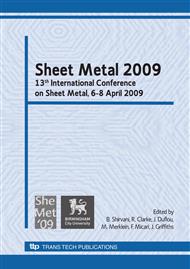p.459
p.467
p.473
p.481
p.493
p.503
p.511
p.521
p.533
Potential of Melted Polymer as Pressure Medium in Sheet Metal Forming
Abstract:
The development of manufacturing methods for producing plastic-metal hybrid structures has already opened new possibilities for lightweight design. Contrarily to the existing technologies i.e. Insert, Outsert and Hybrid Technology, the new forming process “Polymer Injection Forming” (PIF) offers the advantages associated with injection moulding technology and hydroforming technology in a way that hybrid structures can be produced in a single step. The polymer which is used as pressure medium in a melted state to form geometrical features in the sheet metal remains as a functional part in the final hybrid structure. This paper focuses on the experimental investigation of Polymer Injection Forming. Particularly, the interaction between process parameters of injection moulding including injection pressure, cavity pressure, volume flow rate, melt temperature and the resulting part properties e.g. shape and strain distribution of the sheet metal structure from the preliminary results are discussed. The experiments comprise the bulging of a (free form) dome geometry and simple cup geometry of Aluminium and steel sheets by using thermoplastic Polypropylene (PP) as working medium.
Info:
Periodical:
Pages:
493-501
Citation:
Online since:
March 2009
Price:
Сopyright:
© 2009 Trans Tech Publications Ltd. All Rights Reserved
Share:
Citation:


